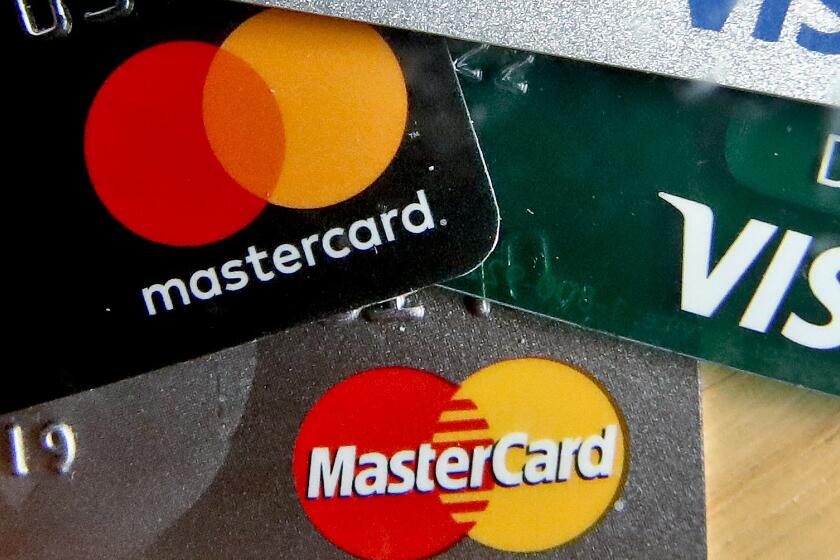Airbus Giant-Jet Gamble OKd in Challenge to Boeing
- Share via
Shareholders of Airbus Industrie on Tuesday approved production of the world’s largest airliner, taking dead aim at Boeing Co.’s decades-long monopoly of the market for large commercial aircraft and threatening to touch off a major trade dispute with the United States.
In a bold strategy to control one of the most lucrative exports in the world, the European-based consortium is risking $11 billion to develop the super-jumbo plane. When it enters service in early 2006, the jetliner that can seat up to 800 passengers will dwarf the largest aircraft available today, the venerable 420-seat Boeing 747.
By virtue of its sheer size, the super-jumbo jet--called the A380--also promises to usher in a new era of air travel, much the way the 747 did when it was introduced more than 30 years ago. The double-decker A380 will have communal space for a casino, a children’s playroom and a gymnasium.
“Airbus has a new flagship,” said Manfred Bischoff, chairman of the world’s second-largest airplane maker, based in Toulouse, France. “We are convinced that this aircraft will have a bright and extremely successful future.”
But the much anticipated decision was overshadowed somewhat by an international spat that quickly reverberated across the Atlantic Ocean and placed the new Airbus jet at the center of a potential trade war. With 80,000 jobs to be created in the Airbus program, the economic stakes are enormous.
Just hours before the Airbus announcement, the European Union angrily rebuffed warnings by President Clinton that European leaders risked a transatlantic trade fight by providing government subsidies to develop the airplane.
The Clinton administration said Monday that while any action against Airbus would have to come from President-elect George W. Bush, the U.S. could file a complaint against the European Union with the Geneva-based World Trade Organization.
EU Threatens Its Own Complaint
Seattle-based Boeing, the world’s largest aircraft maker, has long complained that its bitter rival receives government loans at below market interest rates and is likely to do so again with the new airliner.
The European Union angrily rejected the claim and launched its own volley, accusing Boeing of receiving subsidies from NASA and the U.S. military and threatening to lodge a complaint of its own if the U.S. seeks WTO intervention.
“If the U.S. would really take WTO action against this, then we would feel incited to also take on Boeing and the massive subsidy issue,” Gunner Wiegand, a European Commission foreign affairs spokesman, told Bloomberg News.
A Boeing spokesman said that Bush has not yet taken a position on the issue but that its complaints against Airbus have support from both Democrats and Republicans.
The trade tiff reflects the high stakes involved in launching and making a new airplane. With the decision to go ahead with production, Airbus will be staking its future on a market that has long been dominated by Boeing Co.’s 747.
Because of the A380’s unprecedented size, it will pose some unique challenges to airlines and airport operations.
Just Tuesday, Heathrow Airport, outside London, said it will need to extend a runway and build new hangars to accommodate the new plane. The jet’s passenger capacity--from 550 to 800--will also pose new issues for airlines that typically run on tight schedules.
Airbus officials estimate it will cost $10.7 billion to produce the first plane, although aerospace analysts believe that the final cost could exceed $15 billion.
The company, a European consortium that includes the 11-nation European Aeronautics Defense & Space Co. and Britain’s BAE Systems, has already spent about $1 billion in design and development.
It has also offered steep discounts to sign up so-called launch customers. Some analysts believe Airbus is discounting the A380, which was renamed Tuesday from its earlier designation as the A3XX, by more than 30% from its list price of $230 million per plane. If so, the discounts on planes already ordered would amount to $3.5 billion, adding substantially to the cost of the program.
So far, Airbus has received 50 firm A380 orders and options for 42 more from six customers, including Air France and Qantas Airways. Airbus received the targeted 50th order that it said it needed to launch the program last Friday when Virgin Atlantic Airways struck a deal worth $3.8 billion for six A380s.
But the biggest boost came last September when Singapore Airlines ordered 10 A380s with an option for 15 more. The order was significant because Singapore is considered the industry’s most influential buyer.
Meanwhile, Boeing has opted to build a larger version of the 747 with about 520 seats, saying that the potential market for such large jets is too small to justify spending billions to produce an all-new airliner.
Boeing said the 747 variant would cost about $4 billion to produce, significantly less than building a new aircraft from scratch. But so far no customers have placed orders for the plane, known as the 747X.
Boeing insists that only a few hundred super-jumbo jets will be in demand over the next 20 years as more fliers turn to direct flights and avoid going through hub airports to catch a larger plane. Airbus, on the other hand, believes there is a market for about 1,300 such jets worth $282 billion over the same time period.
Adam Pilarski, senior vice president of Avitas Inc., an aerospace research consulting firm, said Airbus had no choice but to build the super-jumbo jet if it wanted to reach its stated goal of garnering 50% of the commercial aircraft business.
Airbus Will Have Full Product Line
By building the super-jumbo jet, Airbus will finally have a full range of aircraft sizes and be in a position to undo Boeing’s stranglehold on the large commercial aircraft market, Pilarski said.
Airbus has maintained that Boeing, because of its monopoly, has been able to charge higher prices for the 747 and “cross-subsidize” other less-profitable, smaller aircraft.
“[Airbus is] past the one-third market share and moving up with the goal of reaching half, but to get there they needed a big plane,” said Pilarski, former chief economist for McDonnell Douglas.
Indeed, Airbus Chairman Bischoff stressed in a statement that the new super-jumbo jet “is a major breakthrough for Airbus as a full-range competitor on world markets.”
Making the plane will be a thoroughly European affair. Aircraft sections will be manufactured in France, Germany, Spain and Britain and shipped to Toulouse for final assembly.
From there the aircraft will fly to Hamburg, Germany, where passenger seats and other cabin equipment will be installed before it is painted.
There could be some American involvement. Airline customers will be able to choose between Rolls-Royce engines or engines being developed jointly by General Electric Co. and Pratt & Whitney.
While the plane can seat up to 800 passengers, typical configuration will have 550 to 650 seats on two decks, the company said.
A third, bottom deck will be available for cargo, rest areas, sleeper cabins and bathrooms. Passengers will be able to board and deplane from the top two decks.
The plane will also be able to fly farther than any airliner available today, with a range of 8,150 nautical miles.
(BEGIN TEXT OF INFOBOX / INFOGRAPHIC)
Double-Decker Airbus
French plane maker Airbus Industrie’s super-sized A380 airliner will seat more than 500 passengers and offer services such as gyms, casinos and lounges. It will dwarf Boeing’s popular 747.
*
Airbus A380
Passenger capacity: 555+
Length: 239 ft., 6 in.
Wingspan: 262 ft.
Height: 79 ft.
Max. takeoff wt.: 1,208,000 lbs.
Range: 9,382 statute miles
Cruise speed: 560 mph
*
Boeing 747
Passenger capacity: 416-524
Length: 231 ft., 10 in.
Wingspan: 211 ft., 5 in.
Height: 63 ft., 8 in.
Max. takeoff wt.: 875,000 lbs.
Range: 8,430 statute miles
Cruise speed: 565 mph
*
* Airline Orders
Orders so far for about 50 planes have come from Qantas, Virgin Atlantic, Singapore, Air France, Emirates Airlines, International Lease Finance Corp.
Sources: Airbus Industrie; Boeing Co.; Researched by JULIE SHEER / Los Angeles Times
More to Read
Inside the business of entertainment
The Wide Shot brings you news, analysis and insights on everything from streaming wars to production — and what it all means for the future.
You may occasionally receive promotional content from the Los Angeles Times.










